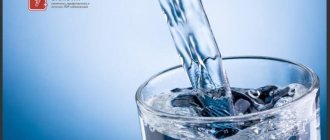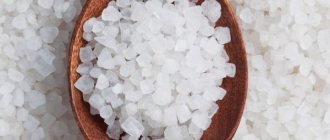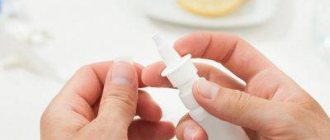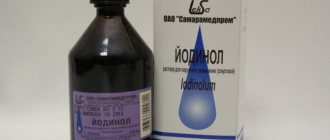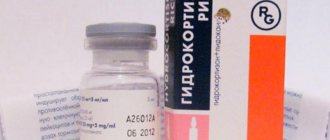Bronchial asthma is considered one of the most dangerous chronic pathologies. Asthmatic attacks require immediate response from the patient. Otherwise, the person may begin to suffocate and die if there is no help.
Currently, there are many different means of combating asthmatic attacks. One of the most effective is the use of a pocket inhaler. Correct operation of this small device allows you to quickly deliver medicine to the bronchi and alleviate the general condition of the patient.
Operating principle and characteristics
A pocket inhaler was developed to relieve bronchial attacks. The use of a small device is considered effective:
- it has compact dimensions,
- fits easily into a pocket or purse,
- You can use such an inhaler in any conditions where the patient is caught in an attack.
In addition, this device is easy to use and has an immediate positive effect. It should be emphasized that using a pocket inhaler requires strict adherence to a number of rules. Otherwise, the product will not have a positive effect.
It is a pocket inhaler, a device consisting of the following parts:
- lid,
- dosage indicator window,
- a mouthpiece that delivers a dose of medication into the respiratory system.
The medicinal solution is under high pressure. Due to this, when pressed, the drug is sprayed and enters the pathology dislocation zone.
Even a child can use this portable device. The main condition for obtaining a positive result is to inject at the moment of inhalation.
Algorithm for using a pocket inhaler
Since a metered dose inhaler is an “ambulance” device, the required dose of the drug that will enter the respiratory tract and have a bronchodilator effect depends on the technique of its use.
Algorithm for using the inhaler:
- 1. shake the inhaler;
- 2. remove the protective cap;
- 3. take a deep breath;
- 4. insert the mouthpiece into the mouth;
- 5. Having started to inhale, press the can;
- 6. After making sure that the medicinal substance has entered the mouth, continue taking a slow, deep breath;
- 7. hold your breath;
- 8. Having taken out the can, exhale through your nose;
- 9. close the inhaler with the mouthpiece.
A mandatory requirement for the inhalation technique is to inhale simultaneously while pressing the canister, otherwise a significant part of the aerosol substance will dissipate into the surrounding air, bypassing the respiratory tract.
As practice shows, errors in the use of inhalation devices are made by more than half of patients, of which the majority of errors are observed in people over 50 years of age.
Description of the device
There are three types of pocket spray:
- powder,
- aerosol,
- hormone.
In turn, according to the type of drug delivery, these options are classified into an auto-inhaler and a device with a dispenser. In addition, for the convenience of the patient, additional attachments are produced: a spacer and an adapter.
A spacer is a nozzle that allows medication to enter the body when inhaled. Such a device is convenient to use, since the supply of medicinal particles does not depend on the correct inhalation.
The adapter also helps deliver the medicine directly to the pathology area. However, its main drawback is its impressive size. Well, as for the types of pocket inhalers, we will consider each in more detail below.
Aerosol
An aerosol inhaler is considered popular. This option has a number of advantages:
- injection of the medicine occurs strictly in doses,
- compact sizes,
- easy to use,
- the cost of this option is quite affordable.
To relieve an asthmatic attack, just shake the balloon and inhale while injecting the drug. This option for obtaining the drug is convenient and does not require much time.
Hormone
The introduction of a hormonal drug by inhalation helps eliminate swelling of the mucous membrane due to the effect of adrenaline. This group of drugs has an anti-inflammatory effect and quickly stops asthmatic attacks. The advantages of a hormonal inhaler include the following:
- the medicine acts on the root cause and does not enter the bloodstream,
- no side effects,
- ease of use.
These options can be used even by children. But only as prescribed by the attending physician.
Powder
A reliable inhaler that has a quick positive effect on the respiratory organ. This option is considered effective for relieving asthmatic attacks. However, powder inhalers are still not very common today. There are several reasons for this:
- quite high cost of the device,
- spraying of the drug should occur strictly at the moment of inhalation of the powder.
In addition, powder inhalers provide the same effect as aerosol inhalers. In view of this, the first option is preferable.
Indications for use
The use of a pocket inhaler is indicated for the following pathologies:
- obstructive bronchitis,
- asthma,
- allergic cough,
- any inflammatory processes occurring in the respiratory tract,
- frequent colds, accompanied by difficulty breathing due to bronchospasms.
It is worth noting that for colds it is useful to use a nebulizer. Inhalations using this device speed up the healing process and alleviate the patient’s general condition.
Types of pocket inhalers
Portable inhalers are divided into two key groups: powder and liquid (aerosol).
Both of these categories are represented by the following varieties:
- Powder. The device is considered highly effective and quickly delivers the required amount of dosed medication to the body. It's easy to use. Usually more expensive than aerosol analogues.
- Aerosol freon. Works with liquid drugs. It has a simple and reliable mechanism. Inexpensive. The key disadvantage is the difficulty in delivering the drug to the respiratory tract. The aerosol gets into them only in the event of a one-time release of the inhalation agent. The patient requires additional explanations from a specialist. Also, the weight of the aerosol is greater than that of the powder. Therefore, sediment may appear in the oral cavity. Especially if the dosage is incorrect. Cases of ingestion are also possible.
- Nebulizer compressor. The device sprays the composition in doses, dividing it into small parts. Therefore, it is easier for the product to reach remote areas of the respiratory tract. A nebulizer allows you to administer an increased dosage of the drug directly into the lungs. It can be used in its pure form - without additives.
- Ultrasonic. The principle of operation is similar to the system of passive inhalers. However, the potential effectiveness is higher. In addition, ultrasound has a beneficial effect on the nasal sinuses, providing a massaging effect and stimulating their natural immune functions.
When choosing a particular device, you should consult a doctor.
Contraindications
Despite the fact that a pocket inhaler is effective for stopping attacks, its use is still contraindicated in some cases:
- at elevated temperatures,
- if a person suffers from frequent nosebleeds,
- for some pathologies of lung tissue,
- with cardiovascular failure.
In general, the portable device in question is considered convenient and easy to use. However, the use of this device must be carried out according to the instructions. The correct algorithm of actions will improve the quality of the manipulations performed, which means that a lasting positive effect will be achieved faster.
In addition, the patient must learn how to use the inhaler correctly. For these purposes, they contact their attending physician and undergo training. The specialist will clearly demonstrate the use of a pocket inhaler and give recommendations to help you easily use the device in the future to relieve attacks.
This information is especially relevant for people who often experience asthmatic attacks.
Pocket inhaler - how does it work?
A pocket inhaler is a device that consists of a cap, a metering device, a dose indicator window and a mouthpiece that delivers a dose of the drug directly into the respiratory tract.
8. Appearance of the device during use
The medicine in the can is under strong pressure. When you press it, the medicine is instantly injected (or sprayed) into the respiratory tract. It is very important that the can is upside down at the time of spraying. This pocket inhaler device allows even a child to easily cope with an asthma attack.
Thanks to the protective mouthpiece, which is clamped with the lips, the medicine enters exclusively into the oral cavity and respiratory tract.
9. Correct position of the can and lips during the procedure
It is advisable that the moment of injection of the drug occurs during inhalation. This is especially true for powder preparations. When using hormonal and aerosol formulations, a positive effect can be achieved even if no inhalation was taken at the time the drug entered the respiratory tract, but it helps distribute the drug through the respiratory tract faster and better.
IMPORTANT! At the moment of injecting or spraying the drug, like a powder or aerosol type of medicine, you should not exhale.
After inhalation, it is advisable to hold your breath for a few seconds. This will enhance the effect of the drug.
ATTENTION! Asthmatics are prohibited from smoking or being in the same room as smokers. Immediately after inhalation, contact with smoking people is prohibited.
Advantages and disadvantages
A portable device designed to be worn constantly has a number of advantages:
- ease of use,
- no need for preparation,
- The procedure can be carried out in any convenient place,
- the risk of side effects is reduced to zero,
- has a positive effect directly on the source of inflammation, bypassing the liver.
However, in addition to advantages, such a compact device also has disadvantages, such as:
- if bronchial patency is impaired, the drug does not penetrate well into the site of inflammation,
- the medication often irritates the mucous membrane of the respiratory system.
Today, steam, ethereal, oil and heat-moisture procedures are used in medicine. However, such manipulations can only be performed at home using an inhaler or nebulizer. The advantage of a pocket inhaler is obvious. Compared to portable devices, it can be carried with you and used anywhere.
Instructions for use
The technology for using a pocket device is quite simple. This is done so that even a child can handle the inhaler. However, carrying out such a procedure still requires adhering to a number of rules in order to correctly block an attack in time.
So, the manipulation technique:
- before inhaling a medicinal drug, you should rinse your mouth with cool water, provided that the inhalation is carried out as planned and is not stopping a sudden attack,
- after that, take a can of medicine, shake it and turn it over,
- hold the inhaler so that the index finger is level with the top of the device,
- Next, remove the fuse cover,
- before the medication is sprayed, you need to exhale deeply and close the mouthpiece with your lips,
- after this, spray the product simultaneously with pressing the dispenser,
- After inhalation, the mouthpiece is removed from the mouth.
If all recommendations are followed, the attack can be stopped within one minute.
Training in the use of a pocket inhaler
Rules for using a pocket inhaler vary depending on its type. Specific features and operation can be found in the instructions for the device. And also during a consultation with a doctor. Here are only general principles that are typical for most devices.
Be sure to wash your hands before each use.
Aerosol inhalers without spacer
The technique of use is as follows:
- Shake the inhaler housing.
- Take a deep breath.
- Lightly, but firmly, grab the mouthpiece part with your lips (the teeth should “bite” the device).
- Take a smooth, leisurely breath, pressing down on the inhaler at the same time.
- For 10 sec. stop breathing. The device must remain in the mouth.
- Exhale smoothly through your mouth.
Re-entry - at least after 30 seconds. At the end of all procedures, the oral cavity is rinsed with water.
There is another option (it is considered less effective): instead of the third step, the head is slightly tilted back. The inhalation device is brought 2-3 centimeters towards the open mouth. Next, go to step 4. The further algorithm remains unchanged. However, doctors still recommend the first option - as in the original list.
Aerosol inhalers with spacer
A spacer is a small bottle that is built into the device and helps the medicine reach its destination. It is equipped with two valves (less often - one), an inhalation socket on one side and an opening for the inhalation socket on the other.
Rules of application:
- Insert the mouthpiece into the spacer hole.
- Holding the device and spacer together, shake the aerosol thoroughly. Preferably 4-5 times.
- Place the spacer in your mouth, tightly wrapping your lips around the mouthpiece.
- Sit straight. Look straight ahead. In this position, exhale.
- Press the inhalation valve once, while inhaling the composition. Deep, smoothly and slowly - about 3-5 seconds.
- Release the spacer and remove it from your mouth. Hold your breath for 10 seconds. Then exhale smoothly.
If several portions of the medicine are needed, the procedure is repeated. If the dose of the drug is quite large, you need to take several breaths - one after the other.
Repeated doses of the composition are made at least after 30 seconds.
Powder inhalers
The technique for using the powder device is similar to the previous one. However, there are two small differences in use:
- Inhalation is done quickly. If it is difficult for the patient to take a quick breath, you need to tell the treating specialist about this. Most likely, he will recommend using an aerosol device or a portable nebulizer.
- In the case of the powder type, a spacer is not required.
After completing the procedure, you should also rinse your mouth with water.
Pocket cans
Perform the following manipulations:
- Remove the protective cap from the device by lifting the bottle upside down.
- Shake the aerosol can.
- Exhale intensely.
- Cover the mouthpiece with your lips, slightly tilting your head back.
- Inhale deeply, pressing on the bottom of the balloon as you go. An aerosol composition must be supplied.
- Stop breathing for 5-10 seconds. Take out the mouthpiece part. Exhale smoothly.
- At the end of the manipulations, fasten the protective cap back.
Important note: When entering the composition through the nose, the head is tilted to the other shoulder and slightly back. When introducing the composition through the left nostril, the right nasal wing is pressed against the septum.
It should be borne in mind that the deeper the introduction of the composition, the more effective its administration.
Using Accessories
Sometimes a patient cannot use a pocket inhaler due to health reasons or age. In this case, it is advisable to use a portable nebulizer. The main feature of these electric inhalation devices is that atomized drugs are delivered to the most remote areas of pathology.
Depending on the method of converting the medicine into fine particles, there are several types of portable devices:
- compressor apparatus,
- ultrasonic. Models from Omron have proven themselves especially well,
- membrane
Patients are often recommended to purchase compressor models. Such options are durable in use, can operate on batteries and an accumulator or as a stationary option, and most importantly, compressor devices do not cause the destruction of medications.
Precautionary measures
Considering the huge range of inhaled drugs on the modern pharmaceutical market, before using a particular model, you should carefully study the instructions and become familiar with the features of using a particular portable device.
So, a reminder on the use of pocket inhalers:
- Before each inhalation, as well as after it, you should rinse your mouth well with cool water,
- if a powder model is used, the inhalation should be rapid,
- any medicinal aerosol is used only strictly as prescribed by a doctor,
- After each use, the protective cap should be disinfected,
- the use of such remedies should be strictly according to indications. Do not exceed the dosage prescribed by your doctor or change the drug yourself to an analogue.
And lastly, if after using a pocket inhaler the patient experiences a deterioration in health, you should immediately rinse your mouth with water, rinse your nasal passages with saline solution and seek help.
How to use a pocket inhaler: step-by-step instructions
The use of a pocket inhaler is simple enough that even a child can handle it independently. However, when performing inhalation during an attack, it is necessary to adhere to certain rules for the procedure so that it is beneficial and helps stop the attack in time.
Before starting the procedure, it is advisable to rinse your mouth with cool water to cleanse it of food debris. If inhalation is carried out as planned, then this action will help increase the effectiveness of the procedure. During the relief of an attack, it is not possible to further clean the oral cavity, so you need to use the inhaler immediately after the onset of an attack.
Instructions for using the pocket inhaler:
By following this application technique, you can stop an attack within one minute.
As can be seen from the information described in this article, it is quite simple to carry out inhalations during attacks of bronchial asthma; you just need to have a special device with you. In addition, the importance of correctly performing the procedure cannot be underestimated.
Bronchial asthma is considered one of the most complex and severe chronic diseases that disrupts the lives of many people. The attacks are dangerous because they require an instant reaction, otherwise the patient may begin to suffocate and death will occur.
In recent years, new effective means have appeared to combat bronchial asthma and it is best to use an inhaler. Correct use of a pocket inhaler allows the drug to quickly penetrate the bronchi and thereby alleviate the patient's condition.
Several types of inhalers are used in medical practice.
- Powder pocket inhalers. With the help of such a drug, it is possible to accelerate the entry into the human body of a certain amount of dry powder. The positive side of such a device is its high efficiency, and it is quite easy to use. At the same time, the price for such a device is much higher than for liquid inhalers.
- Aerosol pocket inhalers. Such devices ensure that the required amount of the drug enters the aerosol. The advantage of such a device is its affordable price, ease of use and practicality of the mechanism. The downside is the fact that the aerosol enters the respiratory system if there is a simultaneous release of the drug and inspiration. An aerosol is a heavier agent compared to a powder, and some of it settles in the mouth or is swallowed by the patient.
Rules for using the inhaler
To use the inhaler correctly, you must practice and follow the instructions supplied with the device.
If it is necessary to use a powder device, proceed as follows:
- you need to install a container with medicine in the device
- if the inhaler already contains medication, then simply shake it
- you should take a maximum breath and exhale calmly
- you need to wrap your lips around the mouthpiece and inhale with all your lungs
- you must hold your breath for at least 10 seconds
- you should remove the device from the mouth and exhale calmly
If necessary, the procedure should be repeated and be sure to rinse the mouth after relief occurs.
Instructions for using an aerosol metered dose inhaler are as follows:
- remove the protective cap from the mouthpiece and turn the device with the can upside down
- shake the inhaler several times, then inhale and exhale as much as possible
- clasping the mouthpiece with your lips, inhale as hard as you can and at the same time press the bottom of the balloon
- hold your breath as long as possible, then remove the device from your mouth and exhale
- if indicated, it is recommended to repeat inhalation after some time and rinse your mouth with water after the procedure
Many aerosol-type inhalers contain a spacer, which is a special device for inhalation. When using it, one end is inserted into the device, and the other acts as a mouthpiece.
With a spacer, inhalation is much easier, and the effectiveness of the procedure increases several times.
To perform inhalation using a spacer, it is recommended to do the following:
- remove the cap from the mouthpiece and connect the spacer to it
- shake the inhaler canister and take a deep breath and exhale
- after that, wrap your lips around the spacer, press the balloon and after a few seconds take a deep, smooth breath
- hold your breath for 10 seconds, then remove the spacer and exhale calmly
- After the procedure, disassemble the structure, rinse the oral cavity with water and dry the spacer well
The use of such a simple device significantly increases the effectiveness of the procedure, since the medicine forms a homogeneous mass that quickly reaches the bronchi. In addition, during inhalation with a spacer, all large particles of the drug settle on the walls of the chamber.
Overdose symptoms
Using pocket inhalers not as directed may result in an overdose. More than 10 breaths cause a toxic effect on the heart muscle with the following symptoms:
- heart rate increases
- trembling occurs in the upper extremities,
- Often a person experiences shortness of breath.
If the patient tries to relieve such symptoms with bronchodilator drugs, his condition only worsens. And in severe conditions there is a high risk of a heart attack.
Dosing devices are strictly prohibited for use by people who do not know how to use them. It is important to understand that these drugs can do more harm than good. Therefore, the use of such remedies should be strictly according to indications.



